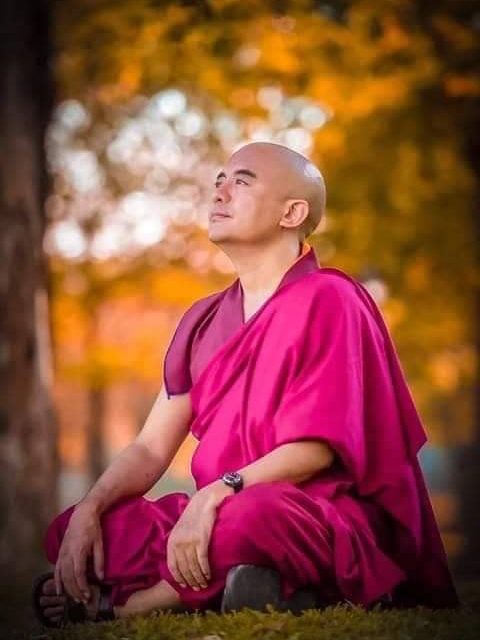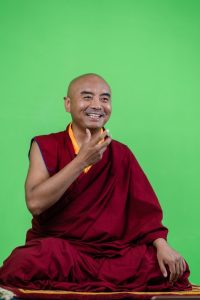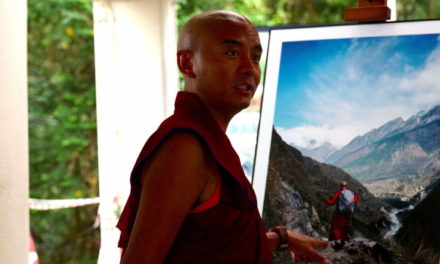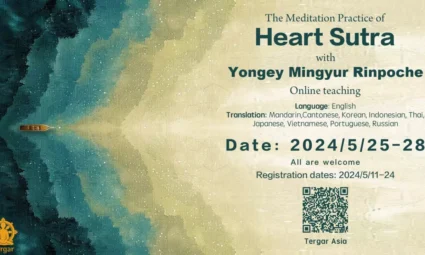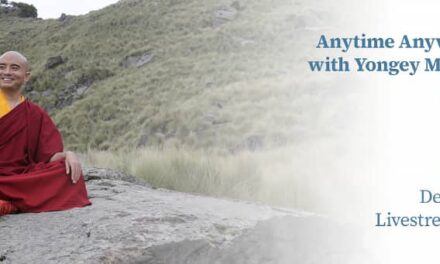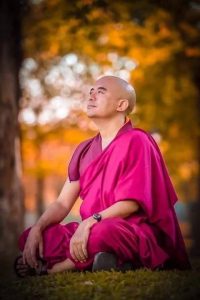 #What did the Buddha do before his enlightenment?
#What did the Buddha do before his enlightenment?
Ever since childhood, the Buddha asked about the meaning of life. He was a prince, he was married, he was rich and powerful and yet he was still not satisfied with his life.
One day he left the palace to look for the answer. Despite studying with the greatest scholars and meditating earnestly, he felt this wasn’t enough and became an ascetic, letting go of food, meditating day and night under a tree at Neranjana river near Bodh Gaya, and became skin and bones. Though he attained jhana experiences in his meditation, he still could not find the real answer. In the end he gave up his retreat and began to accept food, and became healthy again.
The Buddha only found the answer to his question about the meaning of life when he was able to let go of everything, just ‘letting it be as it is’.
Thereafter the Buddha went from the river Neranjana to Bodhgaya where he sat under the Bodhi tree and let his mind be ‘as it is’.
The way he meditated was just to see the nature of reality ‘as it is’. Seeing the nature of the self ‘as it is’, he got the real answer one night.
Rinpoche then asked the audience: ‘Should I tell you the answer or not?’ He then asked through a poll question how many wanted to know the answer? Since 98% wanted to know the answer, and he agreed to give the answer:
The answer is that you don’t have to look anywhere. There is no one to ask any questions. Therefore, there is no answer. The real answer is ‘no answer’. Sometimes we say that the ‘no answer is the best answer’.
#The first teaching after Buddha attained enlightenment
What is the meaning of the entire Heart Sutra?
The meaning of the entire Heart Sutra is that there is ‘no answer, and there is no one asking the question’, so it is emptiness. Buddha found this profound wisdom – the wisdom of emptiness. In one night, the Buddha achieved full enlightenment.
(Rinpoche then recited the sutra in Tibetan)
“Profound and peaceful, free from complexity, uncompounded clear light I have found a nectar-like Dharma.
Yet if I were to teach it, no-one would understand,
So I shall remain silent here in the forest.”
-Śākyamuni Buddha, Lalitavistara Sūtra, XXV, 1
The Buddha gave the first teaching to himself:
‘I found dharma which is like nectar. It is profound, peaceful, luminous, and uncontrived. Even if I teach others, no one will understand. Therefore, I will rest in the forest with silence.’
# The answer cannot be found if we search it from out there.
During the earlier life of Buddha, he was looking for all these answers by looking out, looking in, and looking here and there. All the looking, especially in looking outside of oneself, cannot lead us to the answer.
All the answers are here with us, right from the beginning.
When we look outside of ourselves, we follow concepts. There is a subject and an object, and hence the dualistic mind is at work. We will not get an answer through this dualistic mind or the conceptual mind.
When we cannot get an answer, or we cannot get what we want, what will happen? There will be fear, suffering, sadness, and depression. All these dukkhas will come. At a deeper level we will never be happy.
# For all of us who are always dependent on concepts, we must go ‘beyond concepts’
If you really want to be happy and fulfill that dissatisfaction, longingness, and question, you have to find the real answer.
However, the answer is: ‘there is no answer’.
Nevertheless, the problem is that ‘no answer’ is sometimes difficult to get. It’s difficult to find ‘no answer’ because whatever we do is within the concept. So, the Buddha taught emptiness meditation and how to go beyond concepts. The teachings of the Heart Sutra focus on how to go ‘beyond concepts’.
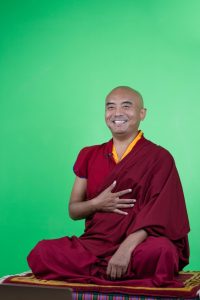 # Are the five skandhas the so called “I”?
# Are the five skandhas the so called “I”?
“Who am I?” was the earliest question that Buddha asked.
When Buddha asked this question to himself and tried to find the answers, what the Buddha discovered was the five skandhas.
Normally we do not know about the five skandhas. What are our feelings and perception of this “I”? We perceive ourselves is a single, permanent, and independent self.
The “single and independent self” solidifies “me”. “I” becomes very touchy, sensitive, moody, and have black or white thinking. It is very narrow, not flexible, and you can say it is quite stupid.
# We do not like gatherings nor being in solitude. Is it wrong in every way?
“Wow, You are very smart!” When someone praises you, this “I” is blooming, and it is strong and intense. On the other hand, when someone tells you, “You are very stupid!”, this “I” may burst into crying or explode like a volcanic eruption.
When you are in a group, suddenly you may wonder “How do they think about me?”, “Do I look okay?”, “Can I talk to them? If I talk to them, will they respond to me?”, “Oh no, I think they don’t see me.”, “Somebody is coming. What should I do?”. All these ideas about “I” are always coming and going.
On the other hand, when you are alone, you may feel lonely. “What should I do? If my friends are here, that will be good. I should grab my smart phone.” You cannot stay with this “I” alone and try to distract yourself.
But when your friends come, you may suddenly think that “They are too noisy and loud; I don’t like them.” You have all these contradictory ideas.
Being alone is not good. Being in the group is also not good. The real problem is that regardless of whatever we do, it is still not okay.
# There is a kind of suffering called “dissatisfaction”
There is one big secret that the Buddha discovered. I don’t know if I should tell you or not. It is a big secret, you know? Anyway, you are all good people so I will tell you. The big secret Buddha realizes is that it is “okay to be with not okay”.
Why? As I told you in the beginning, ”Dukkha” (Pali) is suffering. It is not satisfying. We think this is not good and that is not good. This is not enough. This is not as good as what I expected. There are so many of these. That is what we call “craving, grasping, or attachment”.
# Desire is a bottomless bag
In Pali, it is called “Lobha”, meaning “dissatisfaction”.
“Lobha” or desire, is not satisfying. Lobha, craving or attachment, is like a bottomless bag. A bag without a bottom. Whatever you put inside cannot fill the bag in full.
How to let go of that grasping or attachment?
Just thinking of having no desire does not work but makes it worse. It is because our mind normally does the opposite to what we want them to do.
# Pizza meditation: Mind always goes against what we want it to do
We will try doing this practice together, okay? Normally I teach about pizza mediation. Today I will also teach this mediation. There is one rule when practicing pizza meditation: You cannot think of pizza during this practice until I say okay. When I say okay, you can think of pizza. .
Please keep your spine loosely straight.
Feel your body and relax muscles in your body.
I will say one, two, three. When you hear three, you cannot think of pizza.
One, two, three – no pizza!
No pizza.
Okay.
How was it? Let us do a poll question: how many of you thought about pizza during the practice? If you thought about one or two, it would be a problem. So how many of you thought about pizza during this time?
(Results) There were 66% of you did. So, most of you thought about pizza.
That is how our mind works. When we say “we cannot think”, actually we would think more about pizza. All pizzas come to our mind.
# Anger comes when desire is not satisfied
This craving can never be satisfied. It is always looking for more and more. Due to our nature, we always feel “Everything is not enough and not okay”. When you feel everything is not ok, then aversion comes. Hatred or anger comes. It is called “Dosa” in Pali.
Therefore, we go between these two, aversion and craving, again and again. These are what I normally call the brake and accelerator to drive a car. We need both brake and accelerator to drive a car. For us, the suffering of the car is driven by the accelerator and brake: The accelerator is craving; the brake is aversion.
# Let go and allow everything. It is ok to be not ok.
How to let go of aversion and craving?
Now you see that feeling “okay or not okay” does not work. It does not work to think of “We have to have” so and so. When craving is too tight, what will happen? There will be aversion. We either give up by being too loose or we fight. Therefore, these both are traps.
What we did with breathing meditation was, “okay, let whatever not okay come.” This way, we begin to free the cravings. At the same time, we are not lost. We remember the breath. Being with the breath as it is. That is letting go of the aversion. We are accepting. We are not looking for cravings too much. And we are not getting lost or forgetting. At that moment, we have perfect balance.
# Ignorance, the one which always crave
The root of these two, aversion and craving, is what we call “ignorance”. It is “Moha” in Pali. Ignorance is the root of everything. It is the root of all the sufferings. Aversion and craving come from ignorance.
What is ignorance then? Ignorance is clinging onto me as single, permanent, and independent. That is ignorance.
# Homework: ask “Who am I?” “What am I?”
Today I will give all of you homework. There are two types of homework. One is with a question. You ask “Who am I?” to yourself. First, let your mind go back to your body. Watch your breath for a little bit. Then you ask the question, “Who am I?” Try this for a few minutes.
The second homework does not need to ask questions. Be with the feeling of “me”. There is “me, me, me”. There is the sense of me or feeling of me, isn’t it? So be with that feeling. Therefore, there are two kinds of homework today. Practice for at least five minutes on this homework.
What would it be when we are looking at this “I”? The answer is what I call “two liberations”.
I make funny names for these two types of liberation. One is “horizontal liberation”. The other one is “vertical liberation”. It will be easy for you all to remember if I make funny names for them.
- Horizontal liberation: Cannot see “I”; experience the “no-self” at the “gap”
When you looked at “me”, the first situation is that you cannot not find “me”. You can say you experienced “non-self”. You experienced a gap. You experienced a non-conceptual state.
The duration of it was not very long but only a few seconds. There was a gap. There was a non-conceptual state. And that gap is horizontal because the gap comes between the past and future. From the past to the future, there is a gap. When you looked at “I”, you could not find it. Normally there is a “me, me, me” everywhere. But today when I needed to find this feeling, I could not grab it. It is wonderful!
So this is the secret! If you look at “me”, the sense of “me” or the feeling of “me”, you cannot find it. That is great! That is wisdom. That is liberation and freedom.
Sometimes in the beginning, we may have fear or headache. Sometimes some people may feel that they cannot breathe. Don”t worry. They are all good signs. Or some people are so happy and joyful. These are also good signs.
- Vertical liberation: Can see “I”; “I” becomes the object of awareness
And there is a second secret. When you look at “me” or the feeling of “me”, some of you can see the feeling of “me”. It is great!
The feeling of “me” becomes an object of awareness. It is just like breathing meditation. When you watch your breath, breath becomes support of your awareness. Eventually you will recognize this is just a feeling.
You can see that “me” is only an idea. “Me” is a feeling. Sometimes what you see is your body: maybe “Me” is my body. Maybe “Me” is my mind. Maybe “Me” is my name. Maybe “Me” is my title or my job. Maybe “Me” is like what my friend or my parents say about me or what my children or students told me.
Thus, there are lots of pieces. “Me” is also changing. You can experience “Me” is changing: “Me” when being at home is different from “Me” being in the office. Also, these many pieces – your body, your mind, your job, your title, your name – are all together. If you can see all these, that is wonderful! That is wisdom.
# The so-called “I” is not single, independent, nor permanent
Normally what we believe is that “me” is single. It appears to be not changing so it seems ”permanent”. We think that it is completely under our control so it feels “independent”.
However, when you try to look at this “Me” you may realize:
- Not single: there are lots of parts of this “Me”
Now what you see is that it is not single. There are so many pieces: your body, your mind, your name. There are so many pieces. How other people look at you depends on who this person is: your teacher, your sister, your friend, or your student.
- Not independent: “I” arises from interdependence
It also depends on the culture. There are so many pieces and they are connected and interdependent. It is not fully under our control nor has its own independence but rather arises dependent upon others conditions.
- Not permanent: “I” keeps changing
And this “Me” is changing every day from the morning to the evening. The perspective of “me” always changes so it is impermanent.
Therefore, seeing that is wisdom. When you really look at “me”, you will discover these.
# See the concepts of “Me” then we will not lost in “Me”
Nevertheless, when you are looking at this “Me”, it could also bring along with our usual feelings:
- Permanence: there is an attachment of the permanence of this “Me” and grasping it has this unchanging condition;
- Independent: think of it having it’s own independence;
- Singular: or think that it exists in a singular way.
It is also wonderful if you can see that! It is because now you see these ideas. Normally we don’t see our wrong or mistaken ideas. Now you see the mistaken ideas. Seeing the mistaken ideas is wisdom.
“Seeing me” is what I call vertical liberation. Vertical means it is there. “Me” does not disappear. You can see that “me” is like an idea.
You can see “me” is impermanent and interdependent. Why do I call it liberation? When you see that, it means that you are not lost in “me”.
# Awareness is like the space while “I” is like the clouds
The awareness becomes bigger than “me”. Awareness is observing “me”.
Normally we say awareness is like the sky. The notion of me and all kleshas, thoughts and emotions are like clouds. Our true nature is always free and pure. But we have clouds such as sense of me, kleshas and suffering. We are normally lost in the clouds but now you are separated. There is space. Space and liberation come from the front and back as opposed to the past and future. That is why I call it “vertical liberation”.
# The emphasis is on awareness; just “see”!
To summarize, when you are seeing “Me”, there are two conditions:
- Cannot see:
If you look at the sense of me, maybe you cannot see it. Great! That becomes “horizontal liberation”, a nonconceptual state.
- Can see:
Or maybe you can see it. When you see it, it doesn’t matter what things you see. Whether it is right or wrong, yes or no, whatever you see is okay.
It is the same as breathing meditation. Whether the breath is peaceful or not peaceful, short or long, tight or relaxed, everything is okay. Even though it is not okay, it is also okay. Whatever you see is vertical liberation.
Both are equally good. Therefore, don’t try to make yourself disappear and don’t try to find any other state or things. Okay?
The most important thing is to be aware, to see!
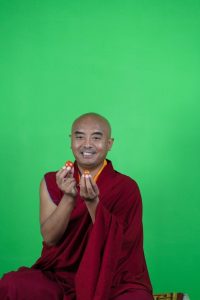 # Bringing Heart Sutra into practice and daily life
# Bringing Heart Sutra into practice and daily life
The Heart Sutra is one of the most important teachings of the Buddha on emptiness. Nevertheless, what is more important is that we have to know how to practice the Heart Sutra and how to bring the meaning of the Heart Sutra to the meditation practice level. Only describing it by words is quite easy but the challenge is how to practice, how to meditate on that, and how to bring this into our own life.
There are two aspects of meditation:
- Shamatha meditation: including the breathing meditation we previously described.
- Vipassana meditation: for the practice of Heart Sutra, we need to look at me, the sense of me or the ego clinging.
How do you look at this “I”? There are many styles for looking at the “I” in Tibetan Buddhism, but mainly there are three:
# First style: simply looking at “I”
The first style is what we already did on the second day of teaching whereby I mentioned not to ask questions. Just look at the sense of “me”, the feeling of “me”, the notion or idea of “me”.
# Second style: ask “Who am I?” repeatedly
The second style is to ask a question. Ask a simple question such as “who am I?”; “who is this?”: or “where do I come from?” repeatedly. You can ask the question in a different style but you will repeat it again and again.
In some traditions, they just practice asking this question: “Who am I? Who am I? Who am I?” They do not practice shamatha step by step. They only ask this question of “who am I”. By repeating this question again and again, you will actually accomplish shamatha because the question becomes the object of concentration; and the meaning of the question becomes vipassana. We also have this style.
In this style, when we ask a question, where we focus is very important. For some people, they feel like “I” is at the head. Some people focus around the head because “I” feels like around the head area. Some people focus on the heart because “I” feels like around the heart. And some people feel that “I” is around the mouth. It depends on you. Wherever you feel this “I”, you ask the question around that area.
We will do a poll question: what about yours? Which area of body you feel like this “I” situates? We will do a multiple choice poll question. Answer 1 if you feel “me” is around your head. Answer 2 if you feel “me is around your mouth. Answer 3 if you feel like around the heart area.
(Poll Result) A majority of you feel it is around the heart. On the other hand, many people in the West feel it is around the head. Feeling it around the mouth is usually less.
Regardless of wherever you feel it, you ask the question of “Who am I?” in that area.
# Third style: ask yourself even more questions
The third style is not only asking and repeating the same question but also going deeper to oneself: “Am I the body? Am I the feeling? Am I the thought? Am I the name or title? Am I my power?” Therefore, we ask more questions.
We did the first two styles by being with the sense of “me” as the first style, and asking and repeating the “Who am I?” question again and again as the second style. These were what I asked you to do yesterday. Today we will go deeper than that. We will ask about all these pieces. We will do this together.
# Go deeper by asking “Who am I?”
Please keep your spine loosely straight.
Relax muscles in the body.
Be aware of your breath.
Now ask yourself a question: “Who am I?”
“Am I my body?” “If you are the body, which part of the body is you?”
“Am I the feelings?”
“Am I the thoughts and emotions?”
“Am I the name, my special job, job title or position?”
Okay, now please relax your body and mind. Just rest for a while.
Next time when you are very angry, you can ask these questions. When you feel depressed, you can ask these questions. When you have cravings, you can ask these questions. When you feel hatred or anger, you can ask these questions. When you are confused, you can ask these questions.
In the beginning, it may bring some confusion. Sometimes it brings headaches or fear. Or some people feel very happy. Eventually it will really help us.

